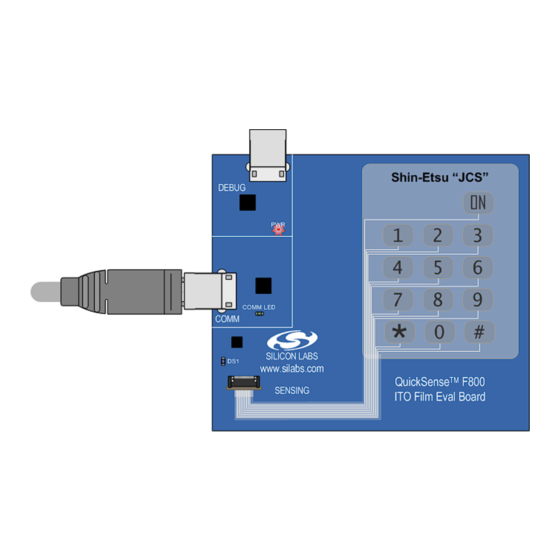
Advertisement
Quick Links
ITO F
ILM
1. Introduction
The ITO Film Evaluation Kit (KeymatEK) implements a demo using a thin film or plastic printed with Indium Tin
Oxide (ITO). The evaluation board features the Silicon Labs C8051F800 with Shin-Etsu "JCS" ITO Film material
printed with a standard keymat pattern. The shapes, patterns, color ink graphics, and thicknesses of the film may
all be customized for the application. For convenience, the board includes the Silicon Labs ToolStick Base Adapter
circuitry for debugging, a CP210x USB-to-UART bridge for communication, and the QuickSense
for sensor performance monitoring and threshold adjustment.
2. Kit Contents
The ITO Film Evaluation Kit contains the following items:
ITO Film Demo Board
ITO Film Demo Board Quick Start Guide
USB Cable
3. Getting Started
3.1. CP210x USB to UART VCP Driver Installation
The ITO Film Evaluation Board includes a Silicon Laboratories CP2103 USB-to-UART Bridge Controller. Device
drivers for the CP2103 need to be installed before the PC software can communicate with the evaluation board
over the USB connection. The CP210x Virtual COM Port (VCP) drivers can be downloaded from the Silicon Labs
"Software Downloads" website (www.silabs.com/mcudownloads). After downloading the drivers, launch the
"unpacker" utility.
1. Follow the steps to copy the driver files to the desired location. The default directory is C:\SiLabs\MCU\CP210x.
2. The final window will give an option to install the driver on the target system. Select the "Launch the CP210x VCP Driver
Installer" option if you are ready to install the driver.
3. If selected, the driver installer will now launch, providing an option to specify the driver installation location. After pressing
the "Install" button, the installer will search your system for copies of previously installed CP210x Virtual COM Port drivers. It
will let you know when your system is up to date. The driver files included in this installation have been certified by Microsoft.
4. If the "Launch the CP210x VCP Driver Installer" option was not selected in step 3, the installer can be found in the location
specified in step 2, by default C:\SiLabs\MCU\CP210x\Windows_2K_XP_S2K3_Vista. At this location, run
CP210xVCPInstaller.exe.
5. If needed, the driver files can be uninstalled by selecting "Silicon Laboratories CP210x USB to UART Bridge Driver
Removal" option in the "Add or Remove Programs" window.
3.2. Running the Demo
Follow these steps to run the ITO Film Evaluation Board Demo:
1. Install the Silicon Labs CP210x USB to UART VCP driver on the target PC following the directions in Section 3.1.
2. Once the VCP driver is installed, connect the F800 ITO Film Board COMM (P2) to the PC using a standard USB cable. The
red PWR LED (DS5) should light up once the board is connected to the PC.
Rev. 0.2 10/09
Downloaded from
Elcodis.com
electronic components distributor
C8051F8
E
XX
Copyright © 2009 by Silicon Laboratories
I TO F i l m - F 8 0 0
K
VALUATION
U
'
G
I T
SER
S
UIDE
TM
Firmware API
ITO Film-F800
Advertisement

Summary of Contents for Silicon Laboratories ITO Film-F800
- Page 1 2, by default C:\SiLabs\MCU\CP210x\Windows_2K_XP_S2K3_Vista. At this location, run CP210xVCPInstaller.exe. 5. If needed, the driver files can be uninstalled by selecting “Silicon Laboratories CP210x USB to UART Bridge Driver Removal” option in the “Add or Remove Programs” window.
- Page 2 ITO Film-F800 3. Wait until the green COMM LED (DS6) lights up. This indicates that the CP210x has enumerated and is ready to communicate with the PC. 4. On the PC, install the Silicon Labs QuickSense Studio software package (www.silabs.com/quicksense).
- Page 3 ITO Film-F800 6. In the Performance Analysis Tool, the “Devices” menu should contain the COM port associated with the CP2103 on the ITO Film Evaluation Board. Click the COM port and the software will automatically connect to the board. 7. To view the channel data in the Performance Analysis Tool, select a channel by clicking inside the white line surrounding the button.
- Page 4 ITO Film-F800 8. The final demo setup should look as follows: Figure 1. ITO Film Evaluation Board Demo Setup Rev. 0.2 Downloaded from Elcodis.com electronic components distributor...
-
Page 5: Hardware Overview
ITO Film-F800 4. Hardware Overview The ITO Film Evaluation Board has three different areas: Sensing, Debug, and COMM. Figure 2. ITO Film Evaluation Board Hardware Overview 4.1. Sensing The sensing area of the board includes the C8051F800 microcontroller, the ITO Film keypad, and one blue LED (DS1). - Page 6 ITO Film-F800 5. PC Software Overview 5.1. QuickSense Studio The QuickSense Studio software facilitates rapid code development and analysis for applications using the Silicon Labs family of QuickSense products. The Studio is comprised of multiple programs that guide users through an intuitive development flow, including graphical configuration wizards, firmware templates, and performance moni- toring tools.
- Page 7 QuickSense Studio section. 5.2. Silicon Laboratories IDE The Silicon Laboratories IDE integrates a source-code editor, a source-level debugger, and an in-system Flash programmer. When using the Silicon Labs IDE with the ITO Film Evaluation board, the setup should be as follows: Figure 4.
-
Page 8: Firmware Description
ITO Film-F800 4. Select “C2” as the debug interface, and press “OK”. 5. Connect to the board by pressing the “Connect” icon, or using the keyboard shortcut Alt+C. 6. Click on the “Download” icon, or use the keyboard shortcut Alt+D. - Page 9 ITO Film-F800 7. Schematics Rev. 0.2 Downloaded from Elcodis.com electronic components distributor...
- Page 10 ITO Film-F800 Rev. 0.2 Downloaded from Elcodis.com electronic components distributor...
- Page 11 ITO Film-F800 OTES Rev. 0.2 Downloaded from Elcodis.com electronic components distributor...
-
Page 12: Contact Information
Silicon Laboratories products are not designed, intended, or authorized for use in applications intended to support or sustain life, or for any other application in which the failure of the Silicon Laboratories product could create a situation where per- sonal injury or death may occur.

Need help?
Do you have a question about the ITO Film-F800 and is the answer not in the manual?
Questions and answers